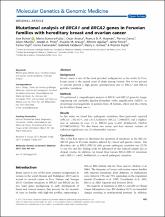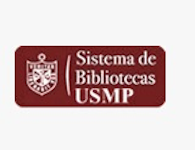Mostrar el registro sencillo del ítem
Mutational analysis of BRCA 1 and BRCA 2 genes in Peruvian families with hereditary breast and ovarian cancer
| dc.contributor.author | Buleje, Jose | |
| dc.contributor.author | Guevara-Fujita, Maria | |
| dc.contributor.author | Acosta, Oscar | |
| dc.contributor.author | Huaman, Francia D. P. | |
| dc.contributor.author | Danos, Pierina | |
| dc.contributor.author | Murillo, Alexis | |
| dc.contributor.author | Pinto, Joseph A. | |
| dc.contributor.author | Araujo, Jhajaira M. | |
| dc.contributor.author | Aguilar, Alfredo | |
| dc.contributor.author | Ponce, Jaime | |
| dc.contributor.author | Vigil, Carlos | |
| dc.contributor.author | Castaneda, Carlos | |
| dc.contributor.author | Calderon, Gabriela | |
| dc.contributor.author | Gomez, Henry L. | |
| dc.contributor.author | Fujita, Ricardo | |
| dc.date.accessioned | 2020-06-01T19:22:28Z | |
| dc.date.available | 2020-06-01T19:22:28Z | |
| dc.date.issued | 2017-06-28 | |
| dc.identifier.citation | Buleje J., Guevara M., Acosta O., Huaman FDP., Danos P., Murillo A., et al. Mutational analysis of BRCA1 and BRCA2 genes in Peruvian families with hereditary breast and ovarian cancer. Mol Genet Genomic Med. 2017; 5(5): 481‐494. | es_PE |
| dc.identifier.uri | https://hdl.handle.net/20.500.12727/6132 | |
| dc.description.abstract | Background Breast cancer is one of the most prevalent malignancies in the world. In Peru, breast cancer is the second cause of death among women. Five to ten percent of patients present a high genetic predisposition due to BRCA 1 and BRCA 2 germline mutations. Methods We performed a comprehensive analysis of BRCA 1 and BRCA 2 genes by Sanger sequencing and multiplex ligation‐dependent probe amplification (MLPA ) to detect large rearrangements in patients from 18 families, which met the criteria for hereditary breast cancer. Results In this series, we found four pathogenic mutations, three previously reported (BRCA 1 : c.302‐1G>C and c.815_824dup10; BRCA 2 : c.5946delT) and a duplication of adenines in exon 15 in BRCA 1 gene (c.4647_4648dupAA , ClinVar SCV 000256598.1). We also found two exonic and four intronic variants of unknown significance and 28 polymorphic variants. Conclusion This is the first report to determine the spectrum of mutations in the BRCA 1/BRCA 2 genes in Peruvian families selected by clinical and genetic criteria. The alteration rate in BRCA 1/BRCA 2 with proven pathogenic mutation was 22.2% (4 out 18) and this finding could be influenced by the reduced sample size or clinical criteria. In addition, we found three known BRCA 1/BRCA 2 mutations and a BRCA 1 c.4647_4648dupAA as a novel pathogenic mutation. | es_PE |
| dc.format.extent | pp. 481-494 | es_PE |
| dc.language.iso | eng | es_PE |
| dc.publisher | Wiley Periodicals, Inc. | es_PE |
| dc.relation.ispartof | urn:issn:2173-9161 | |
| dc.relation.ispartofseries | Molecular Genetics & Genomic Medicine;vol. 5, no. 5 | |
| dc.relation.uri | https://doi.org/10.1002/mgg3.301 | |
| dc.rights | info:eu-repo/semantics/openAccess | es_PE |
| dc.rights.uri | https://creativecommons.org/licenses/by/4.0/ | es_PE |
| dc.source | Repositorio Académico USMP | es_PE |
| dc.source | Universidad San Martín de Porres - USMP | es_PE |
| dc.subject | Genes BRCA1 | es_PE |
| dc.subject | Genes BRCA2 | es_PE |
| dc.subject | Simulación del acoplamiento molecular | es_PE |
| dc.subject | Síndromes neoplásicos hereditarios | es_PE |
| dc.title | Mutational analysis of BRCA 1 and BRCA 2 genes in Peruvian families with hereditary breast and ovarian cancer | es_PE |
| dc.type | info:eu-repo/semantics/article | es_PE |
| thesis.degree.name | Medicina Humana | |
| thesis.degree.grantor | Universidad de San Martín de Porres. Facultad de Medicina Humana | |
| thesis.degree.discipline | Medicina |
Ficheros en el ítem
Este ítem aparece en la(s) siguiente(s) colección(ones)
-
Artículos [274]








